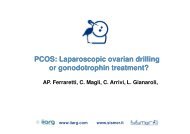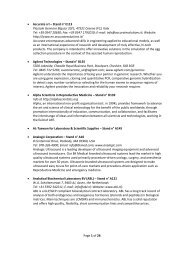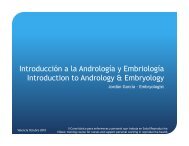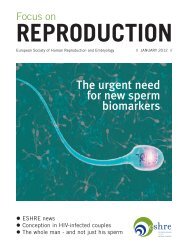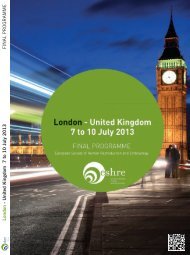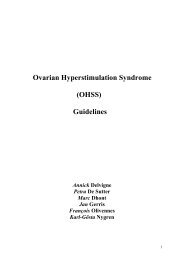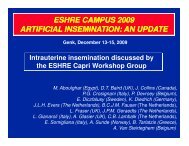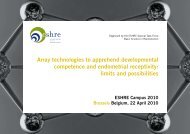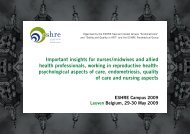Diagnosis and treatment of male accessory gland infections - eshre
Diagnosis and treatment of male accessory gland infections - eshre
Diagnosis and treatment of male accessory gland infections - eshre
- No tags were found...
You also want an ePaper? Increase the reach of your titles
YUMPU automatically turns print PDFs into web optimized ePapers that Google loves.
Department <strong>of</strong> Urology, Pediatric Urology <strong>and</strong> AndrologyJUSTUS- LIEBIGUNIVERSITYGIESSENDIAGNOSIS AND TREATMENTOFMALE ACCESSORY GLANDINFECTIONSW. WeidnerKlinik und Poliklinik für Urologie, Kinderurologie und AndrologieUniversitätsklinikum Gießen und Marburg GmbH- St<strong>and</strong>ort Gießen -Justus-Liebig-Universität Gießen(Direktor: Pr<strong>of</strong>. Dr. W. Weidner)
Andrological Causes forInfertile PartnershipO +O + OO20 %30 %AndrologicalFactoridiopathicOAT-S.hypogonadismtesticular failureobstructioninfectionvaricoceledisorders <strong>of</strong>ejaculationDe Kretser, Baker, J Clin End Met 84: 3343 (1999)Weidner et al., Eur Urol 42: 313 (2002)JLU GIESSEN
Causes <strong>of</strong> Male InfertilityTumors2.3%Immunologic4.2%Systemic5%Obstruction1.5%Malformations 5.8%Cryptorchidism8.5%Hypogonadism8.9%Others6.5%Infections9%Idiopathic31.7%Varicocele16.6%n = 7802 patientsE. Nieschlag et al., 1997; Andrology, Springer-VerlagJLU GIESSEN
<strong>Diagnosis</strong> <strong>of</strong> consecutive 1834 Men with Fertility Problemscryopreservation(n=2)OAT-syndrome(n=635)34.6%general diseases(n=35)1.9%0.1%gynecomastia(n=28)normal1.5% (n=52)2.8%endocrine disorders0.8% (n=14)testicular disorders(n=449)24.5%ejaculatorydisorders /sexualdysfunction(n=34)1.9%3.3%immunologicaldisorders(n=61)8.5% 6.9%<strong>infections</strong> /inflammation(n=155)obstructiveazoospermia(n=126)13.2%varicocele(n=243)Andrological Outpatient DepartmentUrology Giessen (2008)
Infections <strong>and</strong> Male Infertilityacute <strong>and</strong> chronic urogenital <strong>infections</strong>(frequent) Orchitis <strong>and</strong> Epididymitis Prostatitis, Chronic Pelvic Pain Syndrome MAGI (Urethritis)generalized systemic <strong>infections</strong> (rare)JLU GIESSEN
Epididymo-OrchitisSwelling, STD <strong>and</strong> UTI, chronic inflammationUltrasonographyBiopsyRecent results: 100 consecutive patients -> 70% positive microbiologyJLU GIESSENPilatz et al., 2009in press
Testicular Inflammmation <strong>and</strong> Spermatogenesisspermdensitynormozoospermiaoligozoospermiaazoospermia3 - 12 weekstimeJLU GIESSEN
Spermatological Outcome <strong>of</strong>Acute Epididymo-OrchitisOAT - SyndromTesticularazoospermiaObstructive(Epididymal)azoospermia50 % < 1 % < 5 %Weidner et al., Human Reproduction Update, 1999Diemer <strong>and</strong> Desjardins, Encyclopedia <strong>of</strong> Reproduction, 1999Paavonen <strong>and</strong> Eggert-Kruse, Human Reproduction Update, 1999JLU GIESSEN
Chronic Inflammation in Testicular BiopsiesAzoospermiaUp to 14% peritubular lymphocyte-inflammation¹ Mast-cell increase 1,2Interaction to dendritic cells²Association to spermatogenetic failure²- Direct association to bacterial origin is lacking -JLU GIESSEN¹ Schuppe <strong>and</strong> Meinhardt, 2008² Bhushan et al., 2008
ProstatitisNIDDK / NIH ClassificationIIIIIIABIVAcute Bacterial Prostatitis (ABP)Chronic Bacterial Prostatitis (CBP)Chronic Pelvic Pain Syndrome (CPPS)Inflammatory (EPS, VB III, Semen)Non - inflammatoryAsymptomatic (inflammatory)JLU GIESSENKrieger et al., JAMA 292: 236 (1999)
GIESSEN COHORT STUDIESNIH IIIA31.5% ( n=53)NIH IIIA31.0%(n=203)NIH II4.2%(n=7)NIH II7.0%(n=46)NIH IIIB50.0% (n=84)UP14.3%(n=24)NIH IIIB51.0% (n=335)UP11.0%(n=72)Study 20022001-2002n = 168Study 19921985-1990n = 656
4 - SPECIMEN - TECHNIQUE1 : 101.UrineMidstreamUrineEPSUrineafterprostaticmassageJLU GIESSEN
DIAGNOSTIC MANAGEMENTINFECTIONSNIH INIH IINIH IIIurine analysis, culture4 <strong>and</strong> 2 glass test,semen culture,(significant bacteriospermia in about 50%)4 <strong>and</strong> 2 glass test are an indicator forinflammation <strong>and</strong> infectionNIH IVJLU GIESSENno suggestionParis, 2005Consensus ConferenceNIH, EAU, WHO
INFLUENCE OF LEUKOCYTES IN THE EJACULATEON CP / CPPS CLASSIFICATIONTraditional• EPS, VB3 •n=140NIH IIIA 28 %NIH IIIB 72 %New: EPS, VB3 + SemenNIH IIIA 52 %NIH IIIB 48 %1.9 fold more patients to haveinflammatory CP / CPPSJLU GIESSENKrieger et al., 2003
Bacteriospermia in CBP(≥10³ cfu/ml)CBP/NIH II(N= 32)NIH IIIa(N= 102)NIH IIIb(N=142)Controls(N=42)JLU GIESSENWeidner et al., Arch. Androl., 26: 173 (1991)
DIAGNOSTIC PROCEDURESNIH III / CP-CPPSEjaculateEjaculate qualityno influenceEvidence <strong>of</strong> leukocytesAutoimmune markers(complement, T-cells)ImmunoglobulinescytokinesImproves the accuracy for classificationin category IIIa <strong>and</strong> IIIbonly researchJLU GIESSENParis, 2005Consensus ConferenceNIH, EAU, WHO
Cutpoints for EPS, urine after P.M. (VB3) <strong>and</strong>ejaculate/seminal plasma parameters indicative for inflammationparametercutpointEPS leukocytes ≥ 10-20/1000 xVB3 leukocytes ≥ 10/mm³Semen PPL ≥ 0.113 x 10 6 /mlSeminal plasma Elastase ≥ 280 ng/mlSeminal plasma IL-8 > 10600 pg/mlJLU GIESSENWagenlehner <strong>and</strong> Weidner, 2008
Inflammatory Parameters inCP/CPPS <strong>and</strong> Infertile MenNIH IIIaN34NIH IIIbN140Infertile MenN77Age 45 (19-69) 42 (18-69) 40 (15-71)PPL (mill./ml) 0.23 (0-8.24) 0.04 (0-12.08) 0.07 (0-23.04)Elastase (ng/ml) 188 (7-1.708) 95 (4-1001) 91 (2-400)IL-8 (pg/ml) 2,969 (27-10,001) 1,588 (7 – 10,001) 1,602 (13-10,001)JLU GIESSENongoing studyWagenlehner et al.Dresden 2009
Altered Sperm Parameters <strong>and</strong>„Prostatitis“Sperm Parameter Proven Questionable No hintBacteriospermiaOAT-S. +Leucocytospermia +Cytokine response +ROS formation ++CommentCBPtotally unclearCBP, NIH IIIaNIH IIIano new dataSperm antibodiesInflammatoryobstruction(+)-recentlyreconfirmedrareJLU GIESSEN
Male Accessory Gl<strong>and</strong> Infection• Asymptomatic (silent ejaculate infection)• LeukocytospermiaWBC > 1 x 10 6 /mlPeroxidase StainingUnsolved Problems<strong>of</strong> LeukocytospermiaOnly associated withbacterial <strong>infections</strong> in 20 %high rate <strong>of</strong> spontaneousresolution in infertile menWHO, WHO ManualCambridge University Press, 1992JLU GIESSEN
MAGI – CLASSIFICATION SYSTEMGroup AGroup BTypical History/ Urine afterPhysical Signs P-MassageGroup CEjaculate signse.g. UTI,Epididymitis, STDEpididymal swellingAbnormal prostateIncreased PMLPPLC. trachomatis BacteriospermiaC. trachomatisBiochemistryInflammationC. trachomatis PCRPPL > 1 Mill./mlBacteriospermia > 1000 cfu/mlElastase > 250 ng/mlMAGI =a) 2 signs,each from a different groupb) at least 2 ejaculate signsJLU GIESSEN(WHO 1993, 2000)
PATIENTS / METHODS258 infertile men (age 24-69 years)Ejaculate analysis according to WHO analysis <strong>of</strong> PPL (1 Mill./ml), bacteria (10³ cfu/ml), elastase (250 ngl/ml)Exclusion <strong>of</strong> urethritis (1. voided urine: PML, C. trachomatis, N. gonorrhoeae)<strong>Diagnosis</strong> <strong>of</strong> NIH II prostatitis <strong>and</strong> CP/CPPS NIH-CPSI, 4-glass-technique<strong>Diagnosis</strong> <strong>of</strong> chronic epididymitis palpation, scrotal ultrasonographyJLU GIESSEN
RESULTSDIAGNOSIS OF UROGENITAL INFECTION / INFLAMMATIONn 258MAGINIH63 (24.4 %) 101 (39.1 %)including25 epididymitis14 urethritisJLU GIESSEN
RESULTSDIAGNOSIS OF PROSTATE RELATED INFECTION / INFLAMMATIONn 258MAGINIH24 (9 %) 62 (24 %)excluding25 epididymitis14 urethritis“prostatitis“NIH II 26 (10 %)NIH IIIa 36 (14 %)JLU GIESSEN
RESULTSEJACULATE DIAGNOSIS OF UROGENITAL INFECTION / INFLAMMATIONIN DEFINED ENTITIESnEvidence <strong>of</strong>Bacteriospermia PPL Elastase C. trachomatisNIH II 26 x none xx 12 15 noneNIH IIIa36 none 24 20 noneEpididymitis 25 9 9 8 2Urethritis 14 1 4 4 12x15 x E. Colixx> 10³ cfu/mlJLU GIESSEN
CONCLUSIONSThe WHO diagnosis „MAGI“ detects urogenital infection/inflammationin about 20% <strong>of</strong> patients.In this figure, cases <strong>of</strong> epididymitis <strong>and</strong> urethritis are included.Prostate related <strong>infections</strong> (NIH II) are detectablein 10% <strong>of</strong> infertile men.Questionable prostate-related inflammatory changes (NIH IIIa)have to be noted in further 14%.Ejaculate analysis demonstrates leukocytal activity in about two thirds <strong>of</strong>these cases.The MAGI classification <strong>of</strong> the WHO clearly underestimates thepercentage <strong>of</strong> <strong>infections</strong>/inflammatory prostatitis <strong>and</strong>/or CP/CPPS in <strong>male</strong>infertility.JLU GIESSEN
CONCLUSIONSTo exclude <strong>male</strong> urogenital <strong>infections</strong> <strong>and</strong> inflammationin infertile menejaculate analysisclinical investigation <strong>of</strong> the epididymisa 4 glass test for prostatitis diagnosisare m<strong>and</strong>atory.JLU GIESSEN
THERAPEUTIC DILEMMAAntibacterial therapy works in about 70%The persistence <strong>of</strong> inflammation can not be predicted.JLU GIESSEN
SUGGESTED ANTIBIOTIC IN CBP (NIH II)fluoroquinolonestrimethoprim /sulfamethoxazole1. choicein FQ resistence (2-3 months)macrolides gram positives, atypical m.tetracyclines atypical m.aminoglycosidesnot suggestedJLU GIESSENEAU guidelines 2009
Fluoroquinolones in CBPDosage/day Days(mg)n Eradication Follow(%) up (mo)NorfloxacinSchaeffer et al800 28 14 64 6 1990NorfloxacinPetrikkos et al4-800 174 42 60 8 1991OfloxacinPust et al400 14 21 67 12 1989Cipr<strong>of</strong>loxacinWeidner et al1000 14 15 60 12 1987Cipr<strong>of</strong>loxacin Weidner et al1000 28 16 63 21-36 1991Cipr<strong>of</strong>loxacinPfau1000 60-150 7 86 12 1987,1991Cipr<strong>of</strong>loxacinNaber et al1000 28 34 76 6 2000Cipr<strong>of</strong>loxacin vs. 1000 28 78 72 6 2001Lomefloxacin 400 28 75 63 6 2001Naber et alLev<strong>of</strong>loxacin 500 28 136 53 6 2003Bundrick et alNaber et al 500 28 116 84 6 2008JLU GIESSENMeares & Stamey - <strong>Diagnosis</strong>
NIH IINIH IIantibiotics, α-blockers (4 weeks)63-76% bacteriological curefailure - intermittent antimicrobial therapy(acute symptomatic)- low dose suppression- radical TUR-P or prostatectomyJLU GIESSENParis 2005
Sperm Preparation: GlasswoolHenkel und Schill, Andrologia 30 (Suppl 1): 91 (1998)JLU GIESSEN
TARGETS OF THERAPY• Eradication <strong>of</strong> Microorganisms• Normalization <strong>of</strong> Inflammatory Parameters ?Normalization <strong>of</strong> SymptomsJLU GIESSEN
Bacteria - Sperm - InteractionMotility <strong>and</strong> MorphologyAgglutinationAdhesionMembranedamageJLU GIESSENDiemer, Weidner et al.,Int J Androl 19: 271 (1996)Int J Androl 23: 178 (2000)Andrologia 35: 100 (2003)
Bacteria - Sperm - InteractionMotility <strong>and</strong> MorphologyDepending uponSpecies+ E. coli, C. trachomatis- E. faecalis, Staphylococcus spp.NumberTimeDiemer, Weidner et al.,Int J Androl 19: 271 (1996)Int J Androl 23: 178 (2000)Andrologia 35: 100 (2003)JLU GIESSEN
Bacteriospermiacfu/mlfrequency <strong>of</strong> ejaculationJLU GIESSEN




